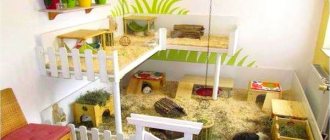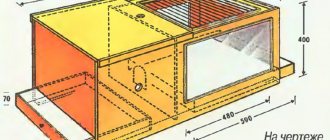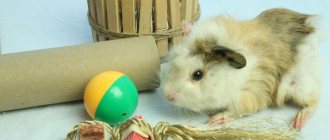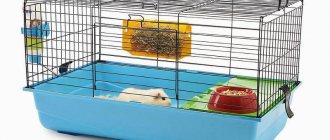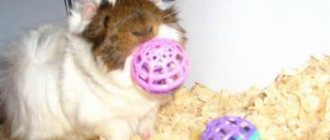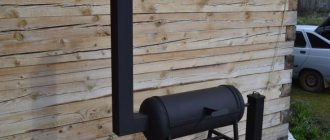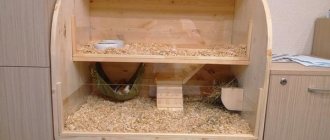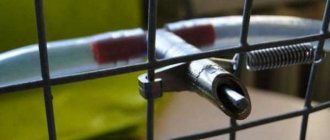03/17/2021 18,538 Guinea pigs
Author: Olga
In order for your rodent to always feel good, he simply needs his own home, the role of which is played by a cage. Without this, his stay in the apartment will be simply impossible. What kind of cage is needed for a domestic rodent, what should the bottom be like in it and why? How to make a cage for a guinea pig with your own hands? What should be the dimensions of a homemade structure? You will learn about this below.
[Hide]
Cage requirements
Although domestic rodents may seem fat and clumsy at first glance, believe me, they are very fast and sharp. Any guinea pig owner can confirm this - you have to try hard to catch an animal that has run out of its cage. Therefore, the size of the structure where your pet will live is very important, especially if you do not allow him to leave the cage.
In general, you should understand that the larger the structure, the more comfortable it will be for the pet, which is why a terrarium or enclosure with a large enclosure always remains the most popular. If you decide to make an enclosure on your own, then this is even better - you can select all the necessary dimensions yourself in accordance with the photos and drawings provided below. The size should be such that the pet can be carried into the cage without any problems, holding it in your hands. In addition, regardless of size, the structure must be more than durable, since pigs can chew not only thick cardboard, but also wood without any problems. In addition, animal feces are quickly absorbed into the cardboard, as a result of which such a house will become a breeding ground for bacteria and diseases.
The best option would be a cage with a plastic bottom and the ability to dismantle the upper part. Why the bottom should be plastic is understandable, all because pigs often gnaw at the bottom of the cage. Additionally, if you have a dune cage, this way you can easily clean and disinfect your pig’s house. In general, in any case, exclude wood as an option for making the bottom of the cage. At a minimum, the bottom should be plastic for hygienic reasons.
How to make a house with your own hands?
Of course, you can buy a house for your pet in the store. But if you do it yourself, you will save money and build a spacious and beautiful house for your pet. Clay flower pots, wooden or plywood products are suitable for these purposes.
You can make a house from corrugated cardboard. To do this you will need:
- corrugated cardboard;
- glue (non-toxic);
- stationery knife.
The process of its manufacture consists of the following stages:
- We cut out the walls of the house. Don’t forget to immediately make windows and doors in them.
- We connect the walls.
- Attaching the roof.
- We place the house in the cage. It is better to install the product at the side of the cage.
Building a plywood house would also be an excellent choice. It can be one or two-level, with partitions and windows. In other words, when making it, owners can show a full flight of imagination.
In fact, you can make a house for your pet from any available materials. These can be wooden mansions, a house made of plastic pipes, products made from natural fabric and much more.
Which is better: a homemade or purchased cage?
In this case, it all depends on preferences and financial capabilities. Of course, if money allows, you can buy a terrarium, an enclosure with a pen or a dune. Why?
Because if the terrarium or enclosure with a pen is metal and nickel-plated, then it will:
- have a longer service life;
- hygienically clean;
- prevent exposure to sunlight;
- last longer even with constant treatment with disinfectants.
It should also be noted that the likelihood that a rodent will damage such a cage is much lower. Especially if you decide to purchase a terrarium or an enclosure with a pen. In addition, structures made of organic glass, getinax or other synthetic materials are cleaner from a hygienic point of view. Among other things, they are more resistant to chemical elements. As for combined materials, such structures are not so durable, but they are much easier to make, so their cost is an order of magnitude lower.
In any case, even at home, you can make and arrange a cage in such a way that it will be reliable. Even if your pigs chew on everything, there are plenty of options for making the structure so that it is durable. Below we will look at how to make it yourself.
Assembly
Assemble the outer perimeter of the future cage from panels of metal lattice, secured with cable ties, which exactly matches the shape of the corrugated cardboard box.
After this, arrange the inside of the cage as you wish: soft fleece bedding, a toilet, a drinking bowl, a feeder and play objects for the guinea pig. As a result, your pet will be happy and excited when she sees a huge area for running and entertainment, which will definitely affect your mood and wallet.
Cage Making Guide
So, if a terrarium or a purchased enclosure with a pen does not suit you, then you can always make a house for a rodent on your own. Moreover, if you have good instructions, you can make a large enclosure with a pen, equipped with additional shelving.
Required tools and materials
Prepare in advance:
- corrugated cardboard (quantity depends on the drawing);
- metal grill with small mesh size;
- plastic cable ties;
- adhesive tape;
- knife;
- scissors;
- meter or tape measure;
- pencil.
Drawing up a drawing
Drawing for manufacturing the structure
As you already understand, the size of an enclosure with a pen for an animal should be large, naturally, if space in the apartment allows. Taking this into account, it is necessary to make a corresponding drawing. In fact, there are many options for making an enclosure with a pen, we will consider one of them. A version of the drawing is shown above.
Sorry, there are no surveys available at this time.
Assembly instructions
- In accordance with the drawing, draw the base on the material, in this case corrugated cardboard. It is better to use corrugated cardboard for an enclosure with a pen because it is a multilayer material. Thus, if you cut through only one layer, this material will bend well. The red lines in the drawing mark those places of the first layer that need to be cut, and the black lines indicate what needs to be cut off completely; this can be done using a regular knife. When the cutting process is completed, you should begin assembling the structure; in this case, keep in mind that the protruding edges of the sides must be securely fixed with tape.
- This way you get a rectangular box, the height of the sides will be 15 cm if you make the designs in accordance with our drawing. Of course, the dimensions can be increased if necessary.
- You should install iron bars along the entire perimeter of the future home for the rodent; they should be cut into panels 0.3 m in size. The edges should be processed if necessary and bent in such a way that your pet does not get hurt during close contact. The metal panels themselves should be connected using ties prepared in advance, and they should also be fixed in the middle. All sides must be assembled separately, this is done so that the so-called walls can be adjusted to size.
- Then the lattice elements must be fastened together using ties, and they must be connected at right angles.
- You can also use plywood as a base, but this material will be less durable. As for the arrangement, in this regard, the cage must be equipped with everything necessary, in particular bedding, a drinking bowl, a feeding trough, a hay barn, etc. It all depends on the imagination.
One more point: if you have several rodents, and you do not want to keep them in one cage for certain reasons, then you can use racks. The rack can be small or large, like in pet stores. Racks are convenient because you can house several pigs in one place without taking up much space. But the rack is not so easy to find, and not everyone can make it with their own hands. You will also find photos of the racks below. Actually, the manufacturing procedure itself is not particularly complicated; anyone can handle it.
Necessary materials
- Multilayer and dense corrugated cardboard,
- Metal mesh or lattice with a mesh no larger than three centimeters,
- Ordinary plastic cable ties,
- Knife,
- Scotch tape,
- Large and small scissors
- Pencils or markers for marking,
- Ruler.
It is best to use cardboard from large household appliances. It's more durable.
To ensure that the cardboard does not allow moisture to pass through, it must be glued on the inside with tape in two or three layers. Some people prefer to cover the inside with acrylic or even fiberglass. Cardboard is an ideal material - it is light, easy to work with, odorless and harmless, and also easy to find. You should be careful when choosing a metal mesh. The recommended mesh is three centimeters, but if you are keeping a family of pigs and planning to produce offspring, you must choose a mesh with a mesh no larger than a centimeter. Otherwise, the kids will crawl all over the apartment.
Adviсe
So, what you need to consider:
- The cage must be equipped with everything necessary, otherwise the pet will not feel comfortable.
- For the bottom, use corrugated cardboard, plastic or other durable material that the pig cannot chew through.
- The iron for the grill must be as strong as possible, otherwise your pet will chew through it without any problems.
- Clean the cage regularly to prevent bacteria and disease.
- The cage must be made in such a way that it can be disassembled and washed without any problems; take this into account when assembling.
- The larger the space, the more comfortable the animal is.
- The air temperature in the room where the rodent is kept should be around 22 degrees. It shouldn't be too hot or cold here.
Cleaning and disinfection
It is worth cleaning your pet's home every day. You can do this not completely, but only where necessary. It is necessary to remove leftover food and feces, and also dry the bottom of the house.
The food needs to be changed daily. If it happens that the animal spills food, it must be thrown away and the pig must be given new food, fresh.
You also need to wash bowls every day. Preferably in hot water and soap. Thus, bacteria will not be allowed to multiply in the food and plate.
Although it is important to clean the cage every day, once a week you need to do a deep cleaning - clean the entire cage completely. To do this, the pig is removed from the cage along with all its accessories. The old filler is thrown away, the entire cage is washed out, dried and fresh filler is added.
It is advisable to place newspaper under the filler. The house needs to be cleaned completely, that is, rid of any stains, stuck food, droppings, and so on. The same is done with a bowl, drinking bowl, and toys. Pigs - there are pigs, even guinea pigs. And they need constant care!
Video “Pig Cage”
A version of a large enclosure with a pen for a guinea pig is presented in the video.
Was this article helpful?
Thank you for your opinion!
The article was useful. Please share the information with your friends.
Yes (100.00%)
No
X
Please write what is wrong and leave recommendations on the article
Cancel reply
Rate the benefit of the article: Rate the author ( 7 votes, average: 4.43 out of 5)
Discuss the article:
Two-story design
To keep several guinea pigs, you can build two-tier houses. This will allow you to separate the recreation area and the food area or assign each rodent a floor. In this case, each animal should have a house, a drinking bowl and a feeding trough.
Such houses are built similarly to one-story ones. On the second floor it is recommended to make a mat from PVC or soft fabric
